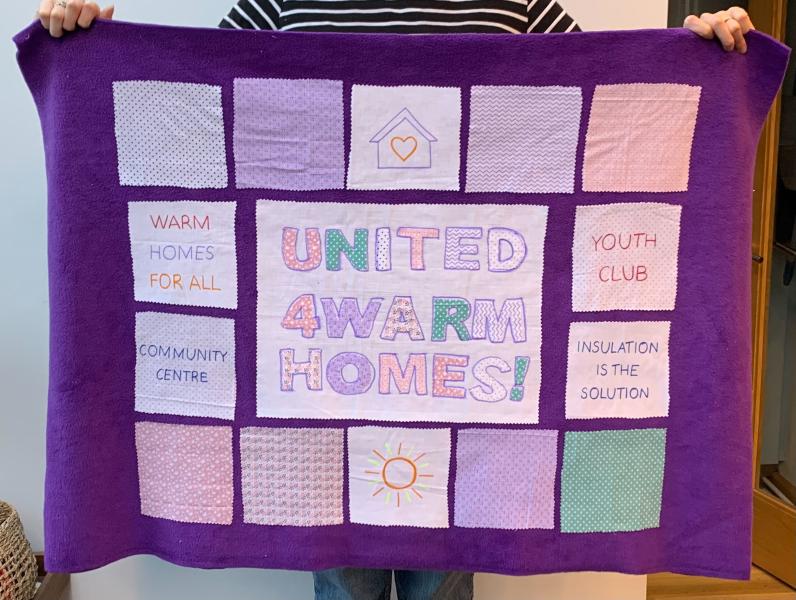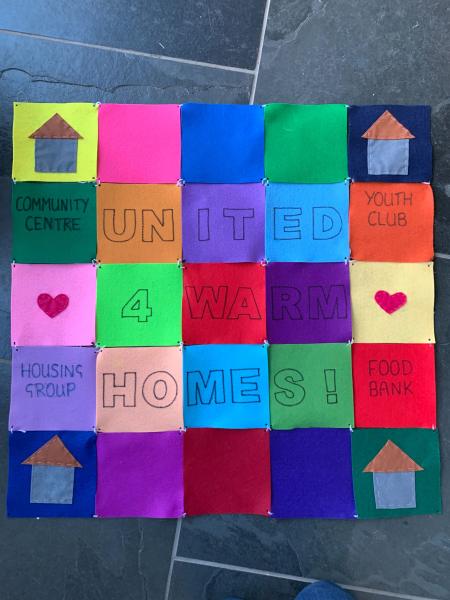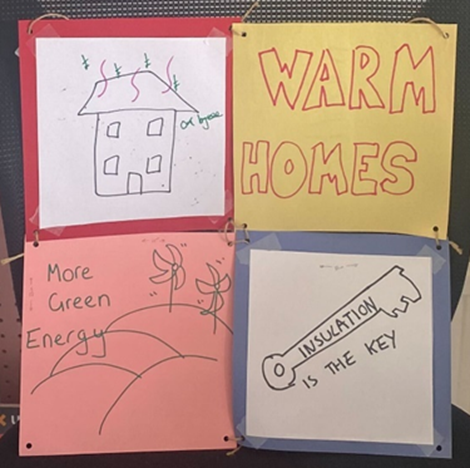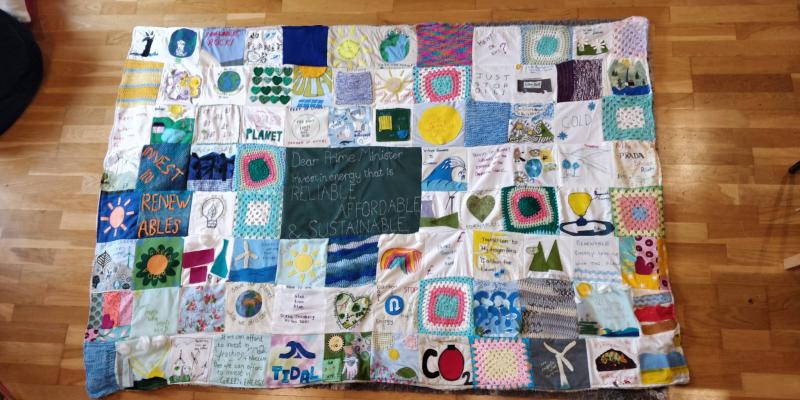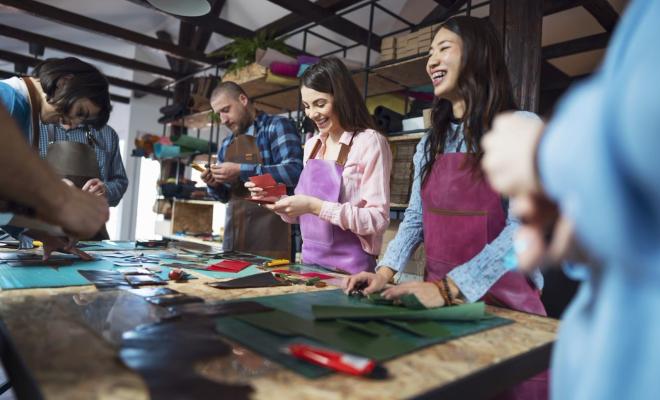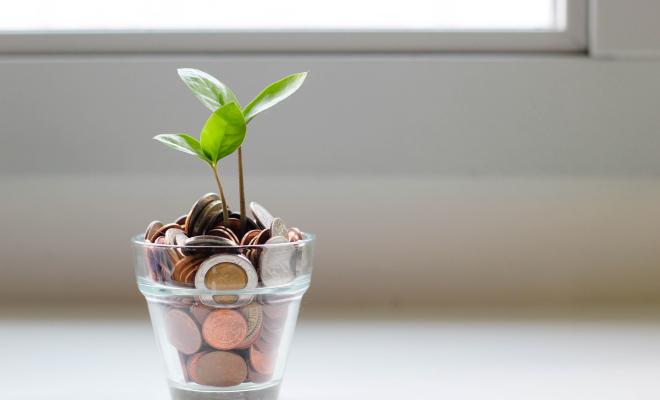31 Aug 2023
Community quilts are a great way to show the diverse and heartfelt support for the campaign from people and organisations across your constituency. Each square will be decorated by local people, showing why they want warm homes that don’t cost the Earth.
It’s also a great way to grab the attention of your MP or election candidates and demonstrate local backing for the campaign.
If sewing isn’t your thing, don’t panic. We’ve got lots of ideas below for making a quilt without even touching a needle and thread.
What to put on your quilt
Every square on your quilt is an opportunity to get our key campaign messages across. Here’s what you’ll want to include:
- Your campaign name. That could be “United for Warm Homes” or “[Your town] for Warm Homes”. Make sure it’s easy to read, including in photos, so that everyone knows who you are and what you’re campaigning for. Use our template letters to cut out your campaign name.
- Support from your community. Invite a wide range of local partners and community members to contribute squares to show their support for the campaign.
- What you’re calling for. The quilt should showcase the solutions we’re calling for, particularly the national street-by-street insulation programme. Invite people to add the changes they want to see to the quilt, for example, “Warm homes for all”; “Insulation is the solution”; “Cut energy bills now”; and “Cheap and clean renewable energy”.
- Why it matters. Most importantly we want the quilt to get across why people care about this issue. Heartfelt messages from your constituency deserve to be heard and will really get your MP and election candidates' attention. These will be personal but might say something like “everybody deserves a warm home,” or highlight how certain communities are disproportionately impacted by fuel poverty.
These messages could be added in writing or communicated through pictures (like our template images). A mix of these will create a beautiful quilt.
You might want to include local facts and figures, such as data on fuel poverty. However, try to keep it simple and focus on why people care.
How partners can get involved
We need to show there’s a strong and broad movement behind our campaign, and we also want to ensure our campaigns are representative of our local community. Have a look at our guide to building partnerships for ideas on how to find local partners.
The quilt is an ideal way to show partners’ support. They can get involved by:
- Adding their organisation’s name and logo to the quilt. This shows the support of a big network of local people. If they can’t sign for the whole organisation or use their logo, they could just include their name and organisation, or an image to represent their community.
- Adding a message from their community and sharing on the quilt why this issue matters to them.
- Hosting a square-making session. You could run a workshop with partners to decorate squares with their members, or give partners materials to use at upcoming meetings or events where there’ll be lots of people, like a coffee morning.
Ensure everyone can get involved. Offer ways for people to contribute to the quilt even if they can’t join a square-making session in person. You could invite people to make a square at home and send it in, or ask people to share their messages and then add them onto the quilt. People could even join in online by sharing their messages of support on social media. It's important to ensure everyone can take part so your quilt is truly representative of your local community.
How to fund your quilt
You’ll probably need to buy a few bits and pieces to make your quilt. You can apply to the United for Warm Homes Fund to help pay for anything you need.
What happens to the quilt when it's ready
The quilt can be an eye-catching part of your campaign, showing your community’s support for warm homes that don’t cost the Earth. You might want to take it to a meeting with your MP or election candidates, keep adding squares to it, use it as a banner on your stalls, display it in your local community, or take photos with it in your local area.
How to make your community quilt
There’s no right or wrong way to make your quilt, as long as you’re able to bring together lots of squares with community messages into one big quilt. You can find lots of quilt-making ideas online, but we’ve got a few suggestions below for how to make one, whether you’re a natural sewer or a craft avoider.
Things to consider in how you make your quilt
Gathering squares from your community
As well as decorating quilt squares at your quilt-making event, you can gather squares from your community in advance. This will ensure you’ve got lots of squares ready to go representing a broad range of local people. You could do this by having materials available on a stall so that people can easily decorate a square. Or you might want to run a square-making session, perhaps with a local partner. Bring along lots of fabric and materials and invite people to decorate a square over a cup of tea. These square-making stalls and events are also a great time to chat about the campaign and invite people to sign your petition.
Bringing your quilt together
It’s a good idea to decide who in your group will be responsible for the logistics of bringing the quilt together, for example ensuring squares are collected from partners in advance and that you have all the materials you need to assemble the quilt. Ask someone to be in charge of this so everything runs smoothly.
Getting too many squares
It's good to have a plan for if you’re super successful and end up with too many squares. Prioritise getting a range of messages and partners onto the quilt to show the breadth of support. If you can’t include all your squares on the day, think about how you can display the additional squares at the event and in the future, such as on a pinboard or in frames. You might even be able to make a second quilt or add more squares around the edge to grow your quilt further.
Quilt-making methods
Now you know everything you need to consider when making a community quilt, have a look through our 4 quilt-making ideas and decide which method is best for you.
Top tips for a successful quilt
- Work with local craft groups. Get their help and advice on making your quilt. They might be able to lend you equipment, donate scrap fabric, or host a community quilt-making session.
- Find scrap fabric. Ask local craft groups and your community for scrap fabric donations, or go searching in charity shops for cheap, second-hand fabric. This’ll help ensure your quilt is as eco-friendly as possible.
- Test out your supplies in advance. However you’re planning to make your quilt, test out a few squares in advance to check your plans will work.
- Embrace the mess. Your quilt might end up looking a little messy, but that just proves it’s been made with love by people from across your community. Don’t feel the pressure to make your quilt too neat, and embrace the community feel.
